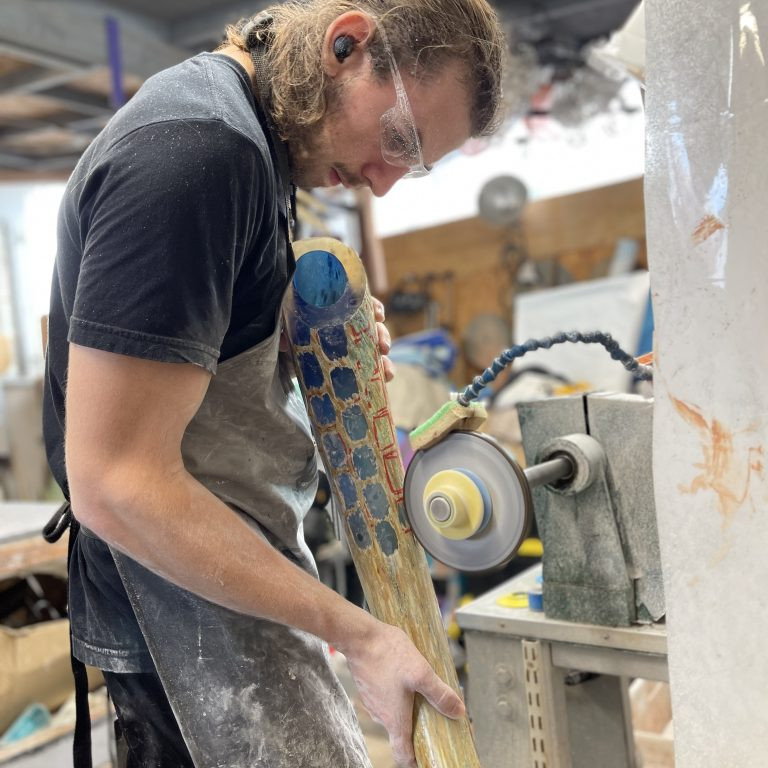Yvette Kaiser Smith Sculptor - Chicago, USA
Can you explain ‘simply’ the technique you use to produce your sculptures?
Fiberglass as a finished product is a fibre reinforced plastic. Fiberglass as raw material is a fibre made from spun glass. It is white, opaque, pliable, and behaves as a heavy cloth. It is commonly combined with polyester resin, a liquid plastic. Normally, the resin wetted cloth is laid into or over a mould until the material cures into a hard, translucent surface.
I start with a form of fiberglass called continuous roving or gun roving. Gun roving comes as a large spool of clustered continuous strands of fiberglass. I crochet the roving with a regular crochet hook to create my own cloth. The “J” hook is just big enough to pick up the mass of the roving. Using a variety of traditional stitches, I crochet flat geometric shapes: circles, rectangles, squares. For the next step, I use a hard finish polyester resin. This is polyester resin with 5% styrene wax. As the resin cures, the wax comes to the surface for a hard finish which is sand able, and eliminates the perpetual surface tack and smell of regular laminating resin. I do not lay my wet fiberglass into a mould; rather I use gravity to create simple geometric shapes. When laid into a mould, the crocheted cloth loses its dimensionality, it becomes flat and ugly.

Fibreglass roving
Summary of process basics:
- • Commit to a number sequence
- • Work out form and colour in drawings
- • Crochet flat shapes
- • Build a jig for draping and forming
- • Pour out the resin, add colour in form of dyes, add hardener, apply resin to crocheted cloth with a 1” or 2” brush
- • Hang resin wetted cloth on jig and recover shape by gently pulling out the edges until it starts to set (between 15 – 30 minutes)
- • Let it harden for 24 hours
- • Cut the edges and make cuts to correct form
- • Sand body and edges of forms
- • Recoat with coloured resin, usually 2 or 3 times
- • Sand down drips
- • Touch up sanded areas with more resin.
If a work is made from several units that are fused together, I now have to:
- • Figure out how to make them fit and temporarily hold together in proper place with cable ties without going insane
- • Sew parts together with the roving
- • Apply resin
- • Sand
- • Recoat with resin
- • Polish with ArmorAll vinyl upholstery cleaner using a 1” brush.

Crocheted Cloth
Can you expand on the mathematics involved in your work and how this came about?
It started with Tim, my husband. Tim is a mathematician by education and a complete math nerd to the core. While driving me from install to install, during long highway trips, Tim used to amuse himself by working out the square root of the multi-digit numbers on the back of big trucks or by trying to deduce whether these long numbers were primes. Or while on vacation or visiting family in the country, Tim would drop to his knees, while all others walked on, to count the leaves on plant life new to his eyes; that number was always a prime. His constant curiosities made me see that math is a part of life, all of life, and cannot be separated from “identity” dialogue.
My reference to math started slowly with an obsession with prime numbers. Utilizing a unique number that is only divisible by 1 and itself was a natural addition as a conceptual tool within identity narratives. Whenever possible I pushed the number of components, or rows, or columns to the nearest prime number. I was convinced, and still am, that repeating nature in this way, that is, fixate on primes, produces a more balanced visual experience.
In 2001, I was working on a show for a university gallery. A wall sized piece takes 3 hard months to produce. I had 2 weeks left and one more large wall to fill. I crocheted 80 plus 10” circles and had the idea to make them ‘the same but different’ in the way that I am same but different from day to day. This involved snapping a graphite grid on the wall to control placement. (I love grids. I have always gravitated towards artwork utilizing grid, I just never found a natural way to bring it into my work.) I wanted to space the circles in a seemingly random, asymmetrical pattern. I asked Tim for a random pattern generator. He said: why don’t you use pi! I said: pi?! Simple interpretation: on the grid, 3 fiberglass circles, space, 1 circle, space, 4 circles, space, and so on. I installed the same piece in 4 different venues, always on a wall that was quite different from the others, I mimicked the wall proportions with the grid, so that I had something like 3 rows by 17 columns or 10 rows by 10 columns. Always I followed the beginning sequence of the infinite number pi, staying true to the number, and always the composition worked!! It was balanced, it was asymmetrical, it was not predictable, and it was beautiful. So now I am obsessed with prime numbers and using pi sequences to generate random patterns. From about 2000 on, most of the work was large and in one piece. Large they were but still limited by standard doorways in the short dimension; and both Tim and I were really fed up with moving these things. From the beginning of this ‘abstracting identity narrative’ stuff I depended on some level of narrative as the source for decisions about material, colour, form, movement, etc.. In 2007 I started working on a solo show for a new, beautiful gallery with a few very large walls. Like a 5 year old, I see a huge wall and I want to fill it. I planned a 10 by 10 foot square. This meant modules. In the thinking / drawing stage, one thing led to another and I thought: Articulate the digits!! Let the number make the work. Grid!! This gave the natural organic feel of the crocheted fiberglass a structure that was missing. And it really felt true in my gut. Everything since then has been number generated.
It was at this time I rummaged through my notes and found small scraps of paper on which Tim suggested, years ago, that I could also use e, another infinite number, and Pascal’s Triangle. I used pi, e, and Pascal’s Triangle to create all the work for the DIGITS show at Alfedena Gallery in 2008. Sequences from pi and e can produce completely different rhythms. There is nothing more true than maths and physics. If I commit to a number sequence, I stay true to it. If it doesn’t quite work for that particular form or idea, I try several sequences on paper until it does what I need it to do.

First Pi Piece
People hear math and run away. My math use is stupidly simple. The numbers are my referent, my source, the thing that creates the work. I am from Western culture so naturally I run sequences from left to right, top to bottom, with some exception. Larger works are straight forward, more obvious, interpretations of each digit, while the source math in the small works is less evident.
Identity Sequence e 4 (2007) is based on the beginning sequence of the infinite number e. It is constructed from 323 small units, 17 rows by 19 columns, to look like an enlarged section of a microscopic organic blueprint. Flesh toned units directly articulate each digit. The four molecule sequence of human DNA determined the use of four alternating colours which serve as the space between each flesh toned digit.

Identity Sequence e
Identity Sequence e Black (2007) is based on the first 49 digits of the number e. I wanted it to feel like a small section that seems to be cut away from a much larger one. Grid is constructed from 49 units in 7 rows by 7 columns. Here the digits are articulated by two systems: tonal gradation of the black where the darkest colour value represents the 9 digit and no colour represents 0; and the distance each unit pushes away from the wall, where units representing the 9 digit push 32” away from the wall and the zeros barely pooch up.

Identity Sequence e Black
Identity Sequence Pascal’s Triangle Green and Red (2007 / 2008) are based on digits from the first six rows of Pascal’s Triangle. Blocks of the same colour represent each digit. The form of each triangle in Pi in Pascal’s Triangle Square and Pi in Pascal’s Triangle Round (2010) is based on the first four rows of Pascal’s Triangle. Four colours are distributed using the first 30 digits of pi. Meaning: I assign colour 1, colour 2, colour 3, colour 4, and then use the digit to drop the colour. For a pi sequence, I count 3 and drop colour 1; count 1 drop colour 2; count 4 drop colour 3; count 1 drop colour 4; and so on. Again, I run the sequence on paper in different colour order because the look of the work, in varied colour distributions, can be quite different.

Identity Sequence Pascal’s Triangles
Size – discuss the size of your work?
Early on, in BFA School I began to understand that every material and process has its own language, its own way to articulate words and ideas. This is one of the principle drivers that took the seminal “I want to abstract narratives of identity” question (1992) to the current crocheting fiberglass into abstract, geometric, minimal number generated forms.
Part of the challenge of understanding a specific material or conceptual language is finding the right scale for that particular form. And, yes, there is always the ‘right’ scale. This is why most of the work from 2000 to 2008 was very large. It took me years to find it and years to explore it. I still believe that the crocheted fiberglass language based on narrative needed to be in that large scale in order to be successful. The number generated work from 2007/2008 changed that. Grid came in. Modules came in. Small components came in. The older, more organic forms needed the scale. The structure of the geometry and pattern released me from that, although the first few number generated works are big.
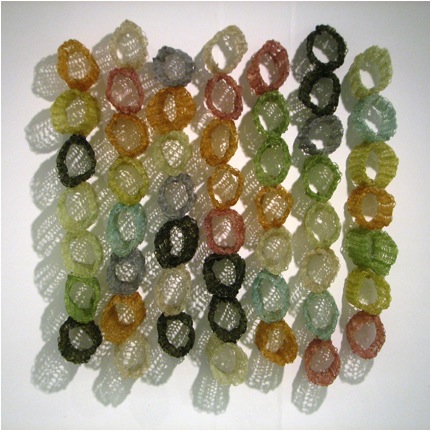
Strands – small work 40x40x7
While making the DIGITS show, I ran out of time, had two small walls, the systems I was developing allowed for a successful 3 x 3 foot and 2 x 5 foot. Six months later I had opportunity to set up an artist booth at The Artist Project art fair. Small walls, actually thinking about selling the work, the new systems allowed and happily resided in this 4 x 4 and 3 x 3 foot scale. These things moved so I stuck in the scale. The work got a little bit smaller as I started using USPS to ship overseas.
Moving (selling and shipping) the work necessitated the scale down which would not have happened without the math structure.
Part of the beauty is the shadows; your work casts comment on this?
At first, the shadow was just a by-product. I soon realized that the shadow, the act of being projected through a solid form, really played into the identity dialogues: which is you, the core of you, is it the body or that which flows through the body and imprints on your environment, that is, your behaviour or even a soul; that kind of stuff. And the shadows were cool. I saw some as drawings. Some had the look of photograms. I enjoyed the reference. With this new conceptual anchor, I wanted to create forms that maximized the shadow drawings, so that the expectation of a certain shadow reaction dictated the form creation and construction. Now that the forms work off of the numbers, a shadow of a curve anchored to a wall can serve as another dimension to complete or close a form. In the more architectural panel pieces, the shadows can draw out or elongate or even create additional elements.
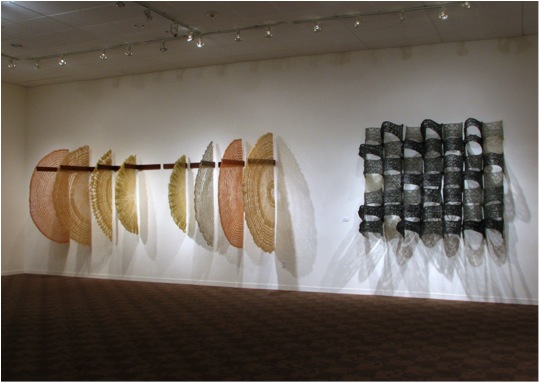
Primary Structures
Discuss your involvement in the Art in Embassy Program?
Art in Embassies creates permanent and temporary art exhibitions in over 200 diplomatic venues worldwide. The temporary group exhibitions are curated by incoming ambassadors or their representatives, usually for the duration of their term.
A significant larger work, Daisy Chain (1999), was curated into the art loaned to Spaso House, the American Embassy in Moscow, Russia for a 4 year period (2002-2006). Also during that time, a smaller work was part of the exhibition at the American Embassy in Ankara, Turkey; this was a 2 year loan. From this exposure, in 2006, I was able to sell a large existing work to be a permanent part of the American Embassy in Abuja, Nigeria. And, Daisy Chain was the month of August in the 2004 Embassy of the United States wall calendar!!

Daisy Chain in Spaso House, Moscow
Comment on the connection between your work, culture and history?
The search for numbers went on for thousands of years; in this respect, numbers represent the human search for knowledge. And, just about every culture, current and extinct, has and had its own lace or knotted cloth tradition. The tradition of crochet and the process of crocheting both embody passing of time, human labour, and innovation and creativity. The narrative based crocheted fiberglass as well as the math driven crocheted fiberglass reference culture and humanness; they represent time and community; the work highlights our connectivity. If identity is a hybrid of our heritage, then lace is, as tradition of time, labour, and creativity, one tiny point of intersection that connects us all.
Your work, due to the base structure, is seen a feminist, how do you feel about this?
The base structure is the logic of geometry and spatial relationships created by number sequences, thank you for acknowledging the math! Oh, you mean the crochet!! Is the work feminist because I am female crocheting? If the same work was created by male would it still be seen as feminist? The work does surface gender issues, but perhaps not the expected. At most, I’d call the work quietly subversive. But I suppose subversive and feminist reside in the same house.
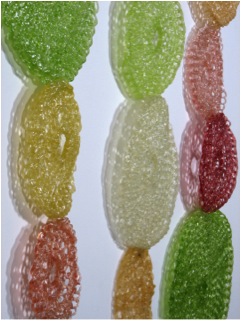
13 Pi Line – detail
It is seen as feminist because of the gender of the maker. I prefer for the art to be received for what it is: objects that are products of an active, long-term material and conceptual exploration; minimal, geometric abstractions that are not generic in form but resonate through specificity. The structure, form and colour distribution within the object is created by math; base materials are fiberglass and polyester resin, industrial and nasty to work with; the technique I use to create my own sculpting material is a craft traditionally attributed to female. That is one out of three key components.
I explore the nature of relationships and identity using formalism while striving for specificity. I began ‘abstracting narratives’ to go beyond the generic in my minimal abstract forms. Identity was a vehicle used to construct the DNA (specificity) of the initial work and then process took over. The work is not feminist, it is formalist and referential. It is a hybrid that defies conventional out-dated labels.
Crochet and lacework is very European does this connect you to your homeland and ancestors?
I was born in communist Prague. Moved to the United States 7 weeks before my 11th birthday. I don’t remember any experience with lace or crochet. In 1999, 30 years later, my Mom and I went back to Prague for the first time. By this time, I was crocheting fiberglass for about 3 years, the forms were on the large end of medium, I was not yet handling the material in the best way, I only used simple stitches, and my identity concepts were still limited.
The trip back home had a significant impact on my studio. What I saw was that Czechs are known for, and are proud of, the best beer on this planet, Czech crystal, and lace!! I, for the first time, realized that Czechs have a tradition of gorgeous lace everything. Every home we visited was inundated with lace: concentric circles on interior door glass; lace curtains; plastic lace on plant pots; lace runners; basically lace everywhere. On the streets, the old ladies seemed to have a sort of uniform which consisted of four items: blouse, slacks or skirt, vest, and shawl. Three of these were usually in pattern, the fourth was solid. This overload of patterns should not have worked but it did.
When I got home, my work exploded. Somehow, recognizing that my heritage comes with a lace tradition, I felt a permission to exploit it more fully. I also realized that, although I was claiming to “articulate narratives of identity in the language of crocheted fiberglass”, I was not utilizing the fullness of the crochet language. I bought a book that catalogues many of the traditional stiches, patterns, and formats and began to exploit this resource more fully. I learned that the more complex stiches created a stronger form and allowed me to work larger. While immersing myself in pattern, I finally began to think outside of the body and saw identity in terms of pattern: internal and external; nature vs. nurture; DNA; social behaviour, how groups affect the individual. The identity dialogue evolved into greater complexity. The sculptures reached their proper large scale. Reaching this scale forced me to develop better handling of the material. All this happened because I went back to Prague, saw lace, and reconnected to that culture and place.
Your work is sculpture: does it become sculpture due to its solidness or size? Please discuss
It doesn’t become sculpture, it is sculpture. Sculpture can be in any scale; it can be solid or hollow. Sculpture is not flat; it possesses mass and volume, as does my work. My forms hang on a wall but they reside in three dimensional space. The wall dependency began as a material / scale necessity and later became part of the material language. Sculpture manipulates and activates space. The sheets of handmade, not prefabricated, fiberglass are manipulated to create forms that break into three-dimensional space. The forms manipulate space by pushing into it, by holding it, by folding it, by squeezing it. Some of the forms are so active they command the entire room in deep three dimensional relief, Etudes from Pi in 5 Squared (2011) for example. Some quietly hover in shallow relief, like Pi Line 22 in 5 (2012), yet they still activate a shallow more personal space. In terms of construction, mine is both an additive and subtractive sculpting process.
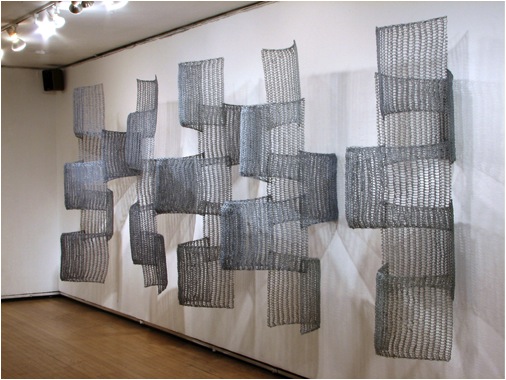
Etudes from Pi in 5 Sq.
Which came first: the fibreglass or the crochet?
The fiberglass.
The ‘abstracting of identity narratives’ stuff began at onset of MFA School (1992). That work explored more common sculpture-student materials like iron wire, lead sheet, copper sheet, plaster, bees wax, wood. I was all over the place. My forms were restricted to body metaphors. I still did not understand scale. I had a copper sheet and iron wire form that did not work on the floor or in any relationship to the wall. As a desperate act to salvage the piece, I brought polyester resin, fiberglass matt, and fiberglass insulation into the studio to make a small stand. During my 1st year, a then 2nd year cast fiberglass cloth into moulds; probably why it came to mind. I knew immediately that fiberglass was the material to explore. Not only for its versatility but also for its natural translucency and skin like splotchiness.
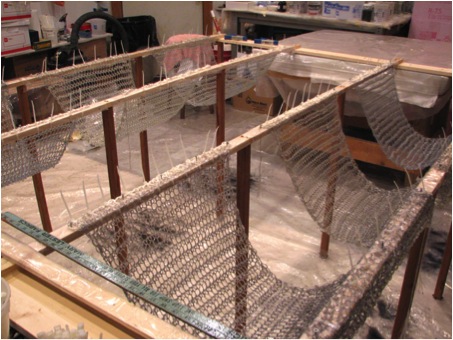
Resin Applied Panels
During the next three years, my studio focused on material exploration, trying to understand the language of fiberglass and how to use it to articulate my conceptual agenda, which was still stuck in one individual, within the body. During this time, I found the roving. Having used iron wire in school for forcing a shape by binding, I bought a spool and began to play. It was all stupid. I shoved the roving in the corner and forgot about it.
Around November 1996, I was starting to work on my first 2-person show, my narrative was still limited to the body, dichotomies a large part of the dialogue; I was at an all-night grocery at one o’clock in the morning, running by the meat counter, from the corner of my eye, I saw tripe!! I stood there frozen in time as thoughts rushed through my head. I saw fat, I saw lace; beauty and ugliness; identity!! Without recognizing why, I associated lace with crochet. The next day I found a hobby store, purchased a book that teaches you how to make pot holders and baby booties, every size of hook available, and began to crochet. It took another 3 years or so before I began to understand the material language of crocheted fiberglass vs. the language of the prefab matt and cloth.
What are you working on currently?
I am making new work for a small solo show here in Chicago at ARTexhibitionsLink’s Gallery Uno that will go up the first week in October. Right after that I begin a 3 week Artist Residency at Ragdale. During the past 3 years, I have been trying to squeeze in time to transition to 2D by experimenting in ways to map the math via Encaustic work. This is what will continue at Ragdale; but my mind is already distracted by the possibilities.
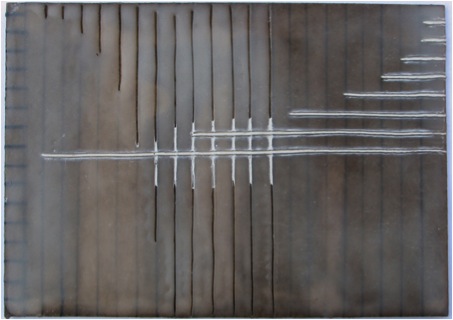
Fibonacci
How do you physically cope with the resin process in you studio?
My studio has a large roof exhaust. I have a full face respirator with two options for filters; a great disposable glove supplier; my body is always fully covered; and at this point, it’s just a normal circumstance of my work.
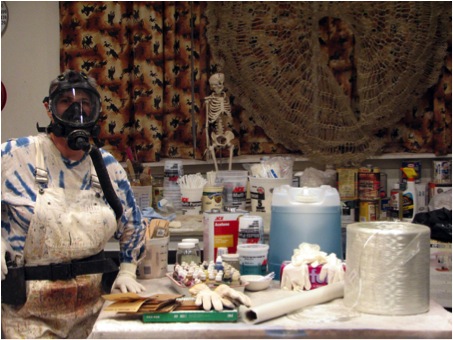
Studio Basics – Wearing Resin Gear
It is the most maddening stage of the material process. With the time constraint of the initial curing time; the full gear I wear, especially in summer when it is 90 in the studio; the sticking to everything if in resin all day; trying not to lose 2 weeks of crochet in one day by not being able to control the form; this is what I call my Three Stooges stage because the resin session can easily turn into dark, one-person Three Stooges episode. If ever I scream in panic, it is in resin application.
It’s just part of the process. It is what it is. I am committed to this process, I believe in it. Much more unpleasant is the sanding!!
Originally your exhibitions were all in Chicago. This year 2012 you have an exhibition in Germany. How did this come about?
In late 2004 I went to a local gallery to hear an artist talk about her work. There I sat next to another artist who was actively working with ARTexhibitionLink, an art organisation founded by art historian Barbara Goebels-Cattaneo, which links the contemporary art scene in Chicago and Berlin. Barbara asks: “Do artworks show geographic or historical adherence or has contemporary art become a global issue, dealing with comparable problems, working with similar standards?”
In March 2005 Barbara was in Chicago; my new artist friend introduced me; I had a show up; Barbara liked the work; that fall she included me in a 3-person show (also featuring my new artist friend) that hung in an alternative gallery in Rome and later in Berlin. We reconnected in 2010; Barbara took my work to Berliner Liste art fair. In the booth across the aisle was Kunsthandlung Huber & Treff, a gallery from Jena, Germany. They listened to me talk about my work, non-stop, for 4 days. The following year Huber & Treff became the curators for an exhibition space in the lobby of Jenoptik Corporation in Jena which was unused for several years. They invited me to be the inaugural show.
A take away from this story is (although I am mostly a recluse) artists leave your studios!!

Jenoptik – Lobby
Artists are becoming global – can you expand how this is affecting your art work?
The shipping difficulty of moving sculpture in terms of cost and dimensional restrictions led to two things. It made me think in modules (the first work I made for ARTexhibitionLink in 2005) which pried open the door to the number generated work. And it continues to challenge me to make smaller, more compact, yet still somewhat intelligent works, which are easy to ship. I like barriers, they push the work where I would not go on my own.
When I travel, I, like many artists, take too many pictures, often of interesting colour combinations or patterns in architecture. Before each project, whether the fiberglass or the 2D work, I run through my sources for inspiration. Math is universal, but I think that the character of a specific geography can be transported through colour and/or rhythm.
Contact Details:
Website:www.yvettekaisersmith.com
Email: yvette@kaisersmith.com
Yvette Kaiser Smith, Chicago, USA
Interview by Deborah Blakeley, October, 2013
Think a colleague or friend could benefit from this interview?
Knowledge is one of the biggest assets in any business. So why not forward this on to your friends and colleagues so they too can start taking advantage of the insightful information the artist has given?
Other artists you may be interested in:





